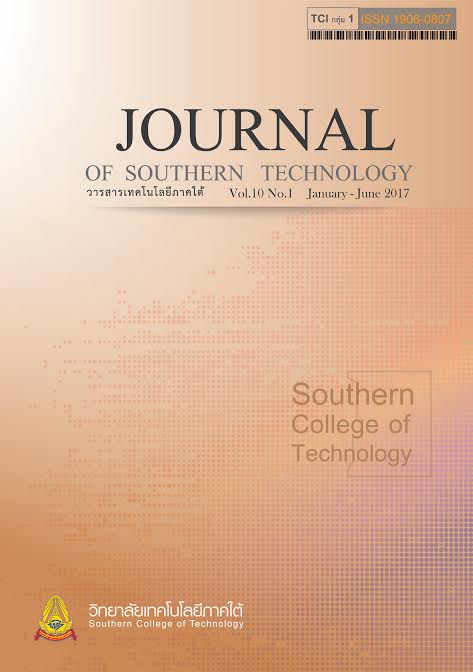การเพิ่มกําไรโดยการเลือกประเภทความสัมพันธ์ของเครือข่ายเศรษฐกิจ
Main Article Content
Abstract
การเพิ่มกําไรโดยการเลือกประเภทความสัมพันธ์ของเครือข่ายเศรษฐกิจ
บทความวิจัยนี้มีวัตถุประสงค์เพื่อวิเคราะห์ข้อจํากัดการแลกเปลี่ยนธุรกรรมในตลาดของสํานักเศรษฐศาสตร์นีโอ คลาสสิก และประเมินค่าขนาดต้นทุนธุรกรรมโดยการเลือกรูปแบบความสัมพันธ์ของการทํางานร่วมกัน วิธีการศึกษาวิเคราะห์ มาจากหน้างานของการเลี้ยงวัวชน และการประสานกิจกรรมในเครือข่ายกลุ่มตัวอย่างใช้ประเภทความสัมพันธ์ร่วมกันทํางาน ร่วมกัน (เจ้าของวัว-ควาญวัว) โดยเป็นกลุ่มตัวอย่างการเลี้ยงวัวแบบประเภทความสัมพันธ์แบบครัวเรือน 27 ตัวอย่างแบบ หุ้นส่วน 11 ตัวอย่าง และแบบธุรกิจเถ้าแก่-ลูกน้อง 13 ตัวอย่างในจังหวัดนครศรีธรรมราช พัทลุง และ สงขลา ที่มีฐานข้อมูล ด้านการเลี้ยงวัวชนในปี 2554-2558 ใช้วิธีการสัมภาษณ์หน้างานของเจ้าของวัว ควาญวัวโดยเก็บข้อมูลแต่ละขั้นตอนของวัฏ จักรการแต่งวัวชน ผลการศึกษาพบว่า สํานักเศรษฐศาสตร์นีโอคลาสสิกขาดการประเมินค่าตัวเลขแลกเปลี่ยนธุรกรรมในตลาดโดย พิจารณาว่าบริษัท และหน้าที่การผลิตของบริษัทในตลาดการแข่งขันมีความหมายเดียวกันนอกจากนั้นการใช้หน้าที่ของกลไก ราคาในตลาดนั้นไม่ก่อให้เกิดรายจ่ายใด ๆ อย่างไรก็ตามข้อบกพร่องของตลาดจากการขาดการเข้าถึงข้อมูลอย่างทั่วถึงและชนิด ของความสัมพันธ์ทางสังคมมีผลทําให้เกิดขนาดของต้นทุนในการแลกเปลี่ยนธุรกรรม เมื่อศึกษาขนาดต้นทุนธุรกรรมพบว่า รูปแบบการเลี้ยงวัวแบบหุ้นส่วนมีต้นทุนธุรกรรมต่ําสุดในภาพรวม สาเหตุจากค่าแรงของควาญวัวส่วนใหญ่ถูกประเมินค่าในรูป ของการลงหุ้นกันและใช้หลักการทุกคนต้องชนะหรือแพ้ร่วมกัน ส่งผลให้เกิดการฉวยโอกาสต่ําของเครือข่ายสามารถควบคุม ต้นทุนธุรกรรมคิดเป็นร้อยละ 8.86 ต่อมูลค่าการเดิมพันชนวัวและควบคุมต้นทุนของค่าแรงควาญวัวและค่าหัวร้อยละ 10 ต่อ ต้นทุนการดําเนินการทั้งหมดคิดเป็นร้อยละ 30.44 และ 4.59 ตามลําดับ เนื่องจากต้องการผลชนะมากกว่าร้อยละ 90 ทําให้ เพิ่มกําไรสามารถดําเนินการได้โดยพิจารณารูปแบบความสัมพันธ์ของการทํางานร่วมกันในฐานะสินทรัพย์ของตนเองผ่านการ สร้างความเชื่อถือและรูปแบบของความไว้วางใจร่วมกัน
Increasing Profits by Choosing the Economy Network Relations
The purpose of this study was aimed to analyze the restrictions on market exchange activities, based on the neo-classical economics, and to evaluate transaction costs by the choice of the collaborative relationship. In present study, the on-site analysis was performed at the cattle livestock and the cooperative activities in the networks. The samples included the types of cooperative relationship (cattle owner-herdsman) including; 27 household relationships, 11 partner relationships and 13 employee and employer relationship in the territory of Nakhon Si Thammarat, Patthalung, and Songkhla. The existing database of cattle livestock during 2011–2015 was adopted. The on-site interview was implemented to enquire the cattle owners and herdsmen. Data collection was conducted in each cycle of cattle decoration.The results showed that the neo-classical economics is deficient in estimating the market transactions; regarding that the company and its production in the competitive markets is common in the meaning. In addition, the function of market price mechanism does not cause any expenses. However, the shortcomings of the market caused by the deficient access to information thoroughly and the forms of social relationships have resulted in transaction costs in the exchange. The results found that cattle raising in partner relationship showed the lowest transaction costs overall, resulted from that herdsman wage is mainly evaluated in the form of a stocks and the win–lose rule is applied, resulted that network opportunism is low. The control of transaction costs represents 8.86 percent stake per betting. The control of labor wage and one’s head of 10 percent per total operating costs accounted for 30.44 percent and 4.59 percent, respectively. As more than the 90 percent winning results is desired, increase in profits is feasible regarding the collaborative relationship patterns as their assets through building creditability and mutual trust.
Article Details
-
Authors must agree to the journal publication rules and allow the editors to edit the manuscripts for publication.
-
Author’s right belongs to the author but Journal of Southern Technology holds the right of first publication and thus allow readers to use the article for the purpose of education but not commercial.

